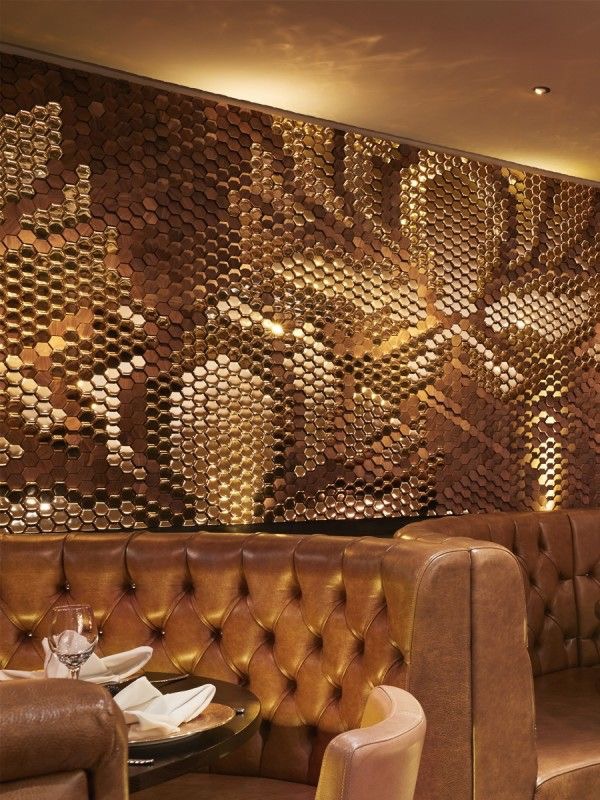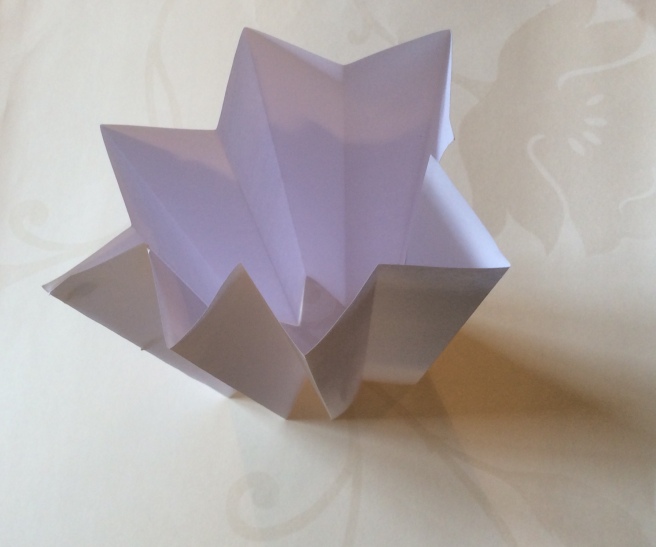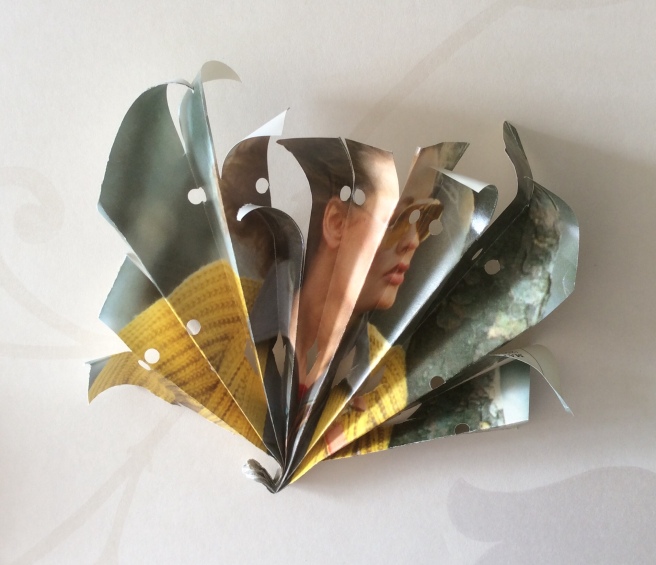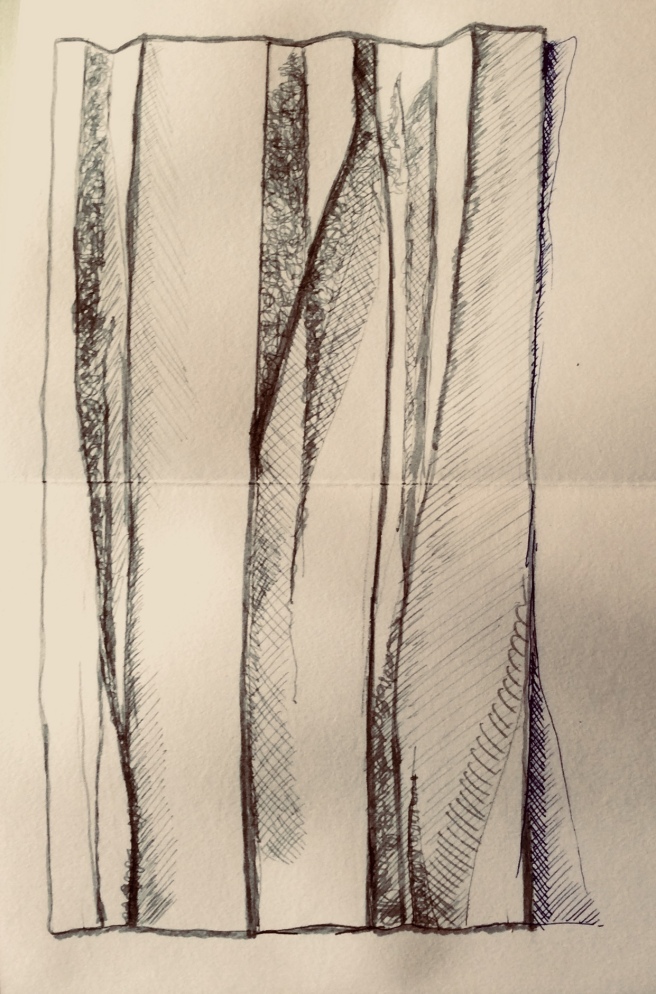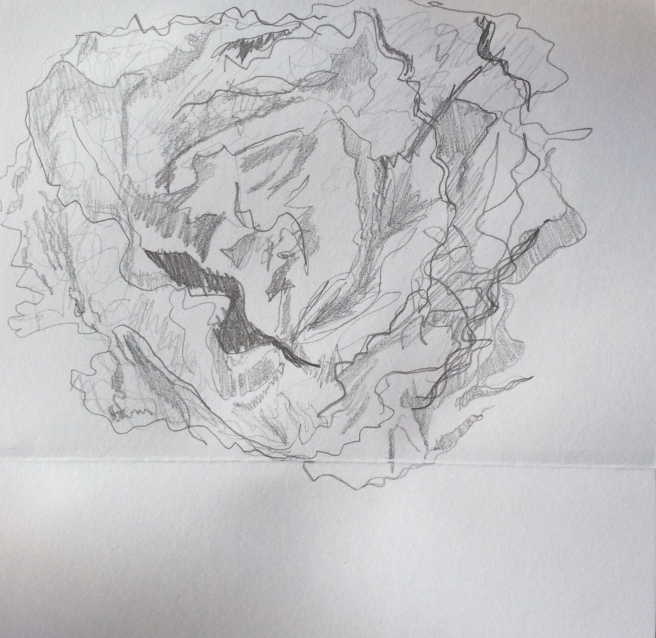Anne uses 100% wool in different colours to create felt which she manipulates by folding, creasing, coiling and layering into repeated organic textured shapes to surface cover walls and panels. These coloured surfaces change the mood, sound and temperature within the space as the felt would absorb sound, and the fabric would also insulate an enclosed space. The light falling on these textures surfaces, if natural or changing would create shadows that would give the appearance of the surface areas moving. I can imagine these designs being very curious to the senses and impactful.
This designers work is all about textured surfacing mainly on a flat plane which she creates through manipulation techniques. This is one method of producing distorted surface and is very relevant to this course because of that.
I could distort fabric to experiment with creating something similar in the manipulation exercises, working with repeat patterning for example.
“Prospectives” Pavilion
Images taken from Pinterest and “Prospectives Pavilion” photos linked to
Giles Miller’s studio produces dramatic wall panels, structures and monuments for public spaces inside and out amongst nature. Much of the work is created in a 3D skeletal format working in frame like structures that makes use of space which reflects and responds to light.
An extensive use of different materials are used to respond to the various projects, these designs and surface areas have been created to work sympathetically with the environment, for example inside with subdued lighting using warm metallic reflective colours, see top photograph, or outside with a large organic form using natural materials.
With the “Prospectives Pavilion” (see bottom three photos) the scales were made from cedar wood that can be adjusted to let in light and air, which would change the shape of the structure but also the surface area would differ in appearance with the changing natural light.
Each scale has been inscribed with a poem or message taken from local schools, the community and contributers to the project and people’s initials scribed on the trees from the surrounding woods.
Looking at the interior of this structure really suggests to me a space that would encourage
sharing ideas, self expression and learning, it also has an ancient feel to it. A pagan place that should be wherever there is human habitation, a place where things get sorted !
how it may be relevant to this part of the course ?
The surface textures of this designers architectural work often has a repeat which could be relevant to the theme of distortion because repeats are also a way of working with paper and other materials to produce interesting surfaces.
most importantly, how it might influence or inform your own practise ?
I will look for similar materials that have depth and texture to manipulate and I am sure will produce some interesting sketches. Also, knowing that Giles Miller likes to work in frame like structuring gets me thinking about holes, apertures and rupturing surface materials, and folding back to reveal another surface or area.

Grace Tan
Refuge by Grace Tan
Grace Tan is a Singapore born artist that set up the company
www.kwodrent.com in 2003.
She works with textiles in unusual ways. By looking at her work it’s clear she is driven by creating work in 3D. This cloudscape pictured above was made from polypropylene loop pins.
I am not sure how I feel about this exhibit, but maybe lying underneath it I would get a different perspective literally, it could be very impressive but I find the synthetic take on a cloud formation rather obvious. Looking at this would make me just go outside and look at the real thing. It also reminds me of cauliflower florets. Maybe if it was dull and grey outside and had been like that for weeks it would be a refreshing and joyful thing to go in and look at?
However what I find interesting is the use of prolypropylene loop pins to create cloud formations which is a clever and inspiring technique and that makes me think I should investigate the use of unusual materials to suggest something completely different from its original state.
how it may be relevant to this part of the course ?
Although I am not that enthused by this particular example of Grace’s work, I do think creating something like a cloud is very clever and most importantly developing shapes in three dimensions is a way of producing distorted surfaces, also her delicate folding of fabrics to create form from blocks of fabrics and cubic tartans are encouraging me to think differently about how your vision-sense can be enhanced by looking through a 3D textiles space.
most importantly, how it might influence or inform your own practise ?
To date, I have not really worked with a 3D plane, this designer does all the time so I am encouraged to start to try out these practises. Origami is familiar to me and I would associate that craft with paper, but it will be interested to experiment with other materials.

Jule Waibel
Jule Waibel is a German designer who is fascinated with the way our universe expands and contracts and doesn’t see why anything else within it shouldn’t also do the same. Her fascination with folding started when she was undergoing an art project at The Royal Collage of Art where she was doing an MA in Design Products in 2013.
Jule works with many different materials including glass, leather, paper, textiles and pvc
and has produced many different products with this same theme of a pleated and folded surface texture, such as furniture, wallets, umbrellas, clothes and vases giving the impression that the object you are viewing can easily change its appearance and form, expand and retract.
Folded trousers – I think this is a very clever design, the folded creased material embraces the form and there is an air of something otherworldly and organic about them, the profile or line silhouette is interesting because it is unexpected. I like the undulating shape that runs down the trousers which gives them a flowing movement and the soft folds remind me of layers of petals or the gills of a mushroom.
The sculptural textured garment makes me curious to want to touch the fabric and crease it in my hands and I would like to see how they move when someone is walking or dancing in them.

Jule Weibel
This object does interest me very much, it’s made from glass so is transparent and absorbs and reflects the light. Some areas of this vase could be seen through and various angled shapes would shine. It looks like you could hold it in your hands, manipulate and crush it, which is outside of our understanding of how that material works in the real world.
It’s angular almost brittle surface appearance reminds me of a boiled sweet wrapper. It’s a suggestion of pushing the boundaries of how things are.
how it may be relevant to this part of the course ?
The initial practical exercises for this assignment focus on folding so this designer fits the brief exactly. Her practise informs me that it is possible to fold a surface material and from that create almost any shape, a shape that may remind us of an object that does not usually expand or retract. This concept encourages us to push the boundaries of conventional design.
most importantly, how it might influence or inform your own practise ?
Looking at form and attempting to describe a form differently will make me think more about construction and how shapes can be described dimensionally.

Mathias Bengtsson
Mathias Bengtsson is a Swedish born industrial and furniture designer that describes himself as an artist. He creates organic, chaotic, flowing structures that has a sense of wild art nouveau. He likes to work with natural products, earth, sand, wood, metal and stone, products we have to hand, that maybe we should focus on this natural resource.
He believes we can borrow from nature and a piece of furniture needs to evoke an emotional response and inspire us rather than be practical. He claims that the design methods of creating furniture that works for us on a utilitarian level was solved back in the 1950’s and do not needs to be revisited.
He designs for himself and each piece is experimental.
The Growth table above in a way, is not like a table. I think its purpose is to be looked at and considered as a structural form, it just happens to be a practical utilitarianism piece of furniture that you can place objects on. I wonder what sense or meaning would objects take on once placed on this table. I can image a large vase of wild flowers spilling out over the table top or a streamline stainless steel coffee pot reminding us of the aesthetic beauty of the piece that the table is supporting, the table itself enhances the beauty of the objects that are placed upon it.

Each project starts with a drawing or painting, from there he can get a real understanding of how the design is going to proceed. The photograph above shows some of his initial working tools, a paint box, sketchbook, and a small machete to name a few items on the table.
how it may be relevant to this part of the course ?
In some ways you would say Mathias does not actually distort the surface of a material, instead he distorts our traditional view of certain objects, using organic shapes and cellular structures to create a new approach to what is expected. I also immediately sense that by observing an object and through that understanding its structural form an informed and sophisticated design can be created, which can evoke curiosity and a feeling of well being. In that sense I would say that Mathias is not a product designer but an artist and this is how he describes himself.
most importantly, how it might influence or inform your own practise ?
I am reminded by the importance of preparatory work, drawings, paintings and models that Mathias prepares before he moves forward with his projects, how relevant and important this process is. Also, it is clear that he is an observer of nature, that he thinks about how things are formed in nature by his cellular and vine like designs. I need to observe in greater detail the objects that inspire me and incorporate that into my work.
Louise Nevelson

1976 wood painted black 96”x 48”x 30.25”
Born in Russia 1899 died in New York 1988
Louise Nevelson was an American Sculptor that worked mainly with wood. Found objects would be assembled and then painted a unifying flat colour, usually black, white or gold. As well as wood she also experimented with other mediums such as bronze, terracotta and plexiglass.
Looking at this image above on a 2D format is in a way quite frustrating, I would like to look at the different angles of the shapes and spaces in between in situ. The matt monochrome colour allows me to focus purely on the shapes and texture of this work. The various tones of colour informs me where various shapes sit on the plane. If more than one colour was introduced it would not work, the colours would be too distracting and interfere and separate the shapes. This unification gives the work order and relevance. Many becoming one.
I can clearly see the different elements that have been applied to the piece, and now they take on a different meaning, now the shapes represent new components.The work has movement, To my eyes the chairs are rotating within a frame like a water mill and I can almost imagine the whole thing coming to life making squeaking and grinding noises as it rotates. This sculpture reminds me of machinery from the Industrial Age and I am sure the “steampunk” movement must to have been influenced by Louise Nevelson’s work.
how it may be relevant to this part of the course ?
Louise creates beautiful and intricate sculptures from everyday discarded found objects.
Her re-use of the ordinary to re-invent and push the boundaries of one form so it becomes another encourages the student to imagine new ways of combining forms and be inventive and I think this will become relevant to this part of the course.
Although Louise Nevelson does not distort the original surface material by a method of connecting the wooden objects she creates a distorted surface.
importantly, how it might influence or inform your own practise ?
Her work suggests to me that I should be look closely at a found object, to use my imagination and formulate new ideas in orderto create something different from the original of creative worth.




